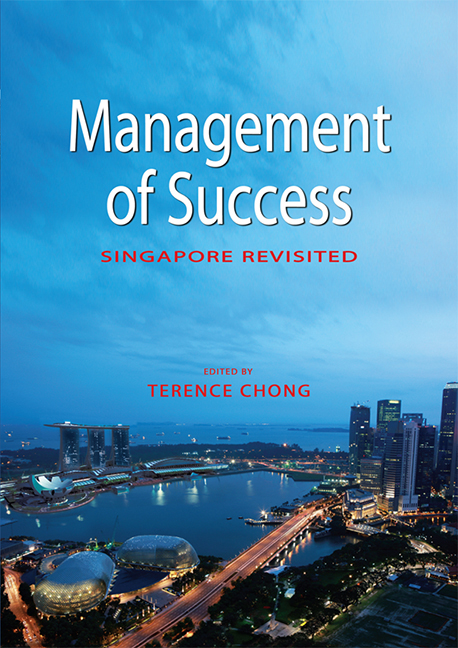Book contents
- Frontmatter
- Contents
- List of Tables and Figures
- Foreword
- Message
- Quote
- Preface
- The Contributors
- 1 Introduction: The Role of Success in Singapore's National Identity
- SECTION 1 SINGAPORE IN THE BIGGER PICTURE
- SECTION 2 LEADERSHIP, POLICY AND POLITICS
- SECTION 3 THE RESTRUCTURING OF THE ECONOMY
- SECTION 4 THE TRANSFORMATION OF SOCIETY
- 11 The Ageing Population
- 12 Managing Labour Flows: Foreign Talent, Foreign Workers and Domestic Help
- 13 Social Mobility in Singapore
- 14 Singapore's Print Media Policy: A National Success?
- 15 Control-shift: The Internet and Political Change in Singapore
- 16 The Transformation of Meritocracy
- 17 Education in Singapore: Sorting Them Out?
- 18 Religious Diversity in Singapore
- SECTION 5 THE LAW
- SECTION 6 MODIFICATION OF THE ENVIRONMENT
- SECTION 7 COMMUNITY AND NATIONAL SECURITY
- SECTION 8 LIFE IN SINGAPORE
- Index
11 - The Ageing Population
from SECTION 4 - THE TRANSFORMATION OF SOCIETY
Published online by Cambridge University Press: 21 October 2015
- Frontmatter
- Contents
- List of Tables and Figures
- Foreword
- Message
- Quote
- Preface
- The Contributors
- 1 Introduction: The Role of Success in Singapore's National Identity
- SECTION 1 SINGAPORE IN THE BIGGER PICTURE
- SECTION 2 LEADERSHIP, POLICY AND POLITICS
- SECTION 3 THE RESTRUCTURING OF THE ECONOMY
- SECTION 4 THE TRANSFORMATION OF SOCIETY
- 11 The Ageing Population
- 12 Managing Labour Flows: Foreign Talent, Foreign Workers and Domestic Help
- 13 Social Mobility in Singapore
- 14 Singapore's Print Media Policy: A National Success?
- 15 Control-shift: The Internet and Political Change in Singapore
- 16 The Transformation of Meritocracy
- 17 Education in Singapore: Sorting Them Out?
- 18 Religious Diversity in Singapore
- SECTION 5 THE LAW
- SECTION 6 MODIFICATION OF THE ENVIRONMENT
- SECTION 7 COMMUNITY AND NATIONAL SECURITY
- SECTION 8 LIFE IN SINGAPORE
- Index
Summary
In 1980, there were 112,000 old people, about one Toa Payoh today … In 2020, there will be five Toa Payohs of old people. So, this is a tidal wave which is coming towards us. In fact, we are the tidal wave ourselves, because the 2020 people will be this generation, many of these MPs who will be standing there and expecting to be supported by the younger generation. And I know that there are many problems which people who are old and people who can see this coming worry about …
— PM Lee Hsien Loong, 2006DEMOGRAPHICS OF AGEING IN SINGAPORE
Singapore's transition from a young, rapidly growing, high fertility population into a rapidly ageing one with prolonged low, below-replacement fertility and low domestic population growth is one of the most significant social transformations the country has undergone over the last fifty years. The magnitude and speed of this demographic development, which will see the population of the old growing into what Prime Minister Lee Hsien Loong has characterized as a “tidal wave” in the next couple of decades, and the flow of young labour force entrants slowing and even declining, has tremendous implications for the country. This was recognized very early by the Singapore Government which, under the leadership of the People's Action Party (PAP), quite characteristically started planning for this eventuality in the 1980s, well before the population became aged. While this early initiative was mired in controversy, it did not dampen the government's determination to tackle the “problem” of the ageing population. Indeed, tackling the “ageing problem” is part of the national agenda. The basic philosophy and approach underlying Singapore's policy on the aged have remained unchanged over the years although the government has also not hesitated to reform specific components to meet present and anticipated needs.
This chapter reviews the Singapore state's response to the ageing of the population to date and assesses its viability going forward. It begins with a review of the demographics. The social, economic, and political implications of these demographic trends are also examined. This is followed by a review of the policy approach and measures that have been adopted by the government to address emerging challenges. Finally, their viability for the future will be assessed and suggestions will be made.
- Type
- Chapter
- Information
- Management of SuccessSingapore Revisited, pp. 183 - 198Publisher: ISEAS–Yusof Ishak InstitutePrint publication year: 2010

